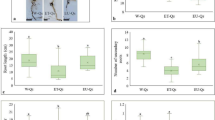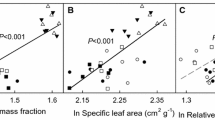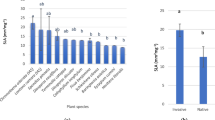Abstract
In nature some successful invasive plants grow faster and are better chemical defenders than native plants, which appears to contradict the conventional theory that plant growth and chemical defense are trade-offs in terms of the allocation of limited resources. Using greenhouse experiments we compared the growth, chemical defensive matters (condensed tannins and total phenolics) and energy-use strategies (construction cost and energy-use efficiency) of four highly noxious invasive plants to their congeneric or co-occurring native species in subtropical China. We hypothesized that the trade-offs between growth and chemical defense in invasive plants are alleviated, and this alleviation benefits from their high photosynthetic capacities and energy-use strategies. Our results showed that all the four invasive plants grew faster than their native counterparts, and three of them had higher condensed tannins and the remaining one had higher total phenolics, indicating the invasive plants achieved both faster growth and stronger chemical defense. Moreover, the growth rate positively related to condensed tannins but negatively to total phenolics in both invasive and native plants, indicating the chemical-specific pattern of the trade-offs. Our results demonstrate that the higher photosynthetic capacity and energy-use efficiency together with lower biomass construction cost facilitated the faster growth and stronger chemical defense in invasive plants, providing an insight for their chemical-specific trade-offs between growth and chemical defense.





Similar content being viewed by others
References
Almeida-Cortez JS, Shipley B, Arnason JT (1999) Do plant species with high relative growth rates have poorer chemical defences? Func Ecol 13:819–827
Arendt JD (1997) Adaptive intrinsic growth rates: an integration across taxa. Q Rev Biol 72:149–177
Baruch Z, Goldstein G (1999) Leaf construction cost, nutrient concentration and net CO2 assimilation of native and invasive species in Hawaii. Oecologia 121:183–192
Baruch Z, Gómez JA (1996) Dynamics of energy and nutrient concentration and construction cost in a native and two alien C4 grasses from two neotropical savannas. Plant Soil 181:175–184
Beaton LL, Van Zandt PA, Esselman EJ, Knight TM (2011) Comparison of the herbivore defense and competitive ability of ancestral and modern genotypes of an invasive plant, Lespedeza cuneata. Oikos 120:1413–1419
Bezemer TM, Harvey JA, Cronin JT (2014) Response of native insect communities to invasive plants. Annu Rev Entomol 59(1):119–141
Blossey B, Nötzold R (1995) Evolutionary of increased competitive ability in invasive non-indigenous plants: a hypothesis. J Ecol 83:887–889
Briggs MA, Schultz JC (1990) Chemical defense production in Lotus corniculatus II. Trade-offs among growth, reproduction, and defense. Oecologia 83:32–37
Broadhurst RB, Jones WT (1978) Analysis of condensed tannins using acidified vanillin. J Sci Food Agric 29:788–794
Caño L, Escarré J, Vrieling K, Sans FX (2009) Palatability to a generalist herbivore, defence and growth of invasive and native Senecio species: testing the evolution of increased competitive ability hypothesis. Oecologia 159:95–106
Cappuccino N, Arnason JT (2006) Novel chemistry of invasive exotic plants. Biol Lett 2:189–193
Carrillo J, McDermott D, Siemann E (2014) Loss of specificity: native but not invasive populations of Triadica sebifera vary in tolerance to different herbivores. Oecologia 174:863–871
Cobb NS, Mopper S, Gehring CA, Caouette M, Whitham CTG (1997) Increased moth herbivory associated with environmental stress of pinyon pine at local and regional levels. Oecologia 109:389–397
Doorduin LJ, Vrieling K (2011) A review of the phytochemical support for the shifting defense hypothesis. Phytochem Rev 10:99–106
Feng YL, Li YP, Wang RF, Callaway RM, Valiente-Banuet A, Inderjit (2011) A quicker return energy-use strategy by populations of a subtropical invader in the non-native range: a potential mechanism for the evolution of increased competitive ability. J Ecol 99:1116–1123
Fine PVA, Miller ZJ, Mesones I, Irazuzta S, Appel HM, Stevens MHH, Sääksjärvi I, Schultz JC, Coley PD (2006) The growth-defense trade-off and habitat specialization by plants in Amazonian forests. Ecology 87:S150–S162
Funk JL, Vitousek PM (2007) Resource-use efficiency and plant invasions in low-resource systems. Nature 446:1079–1081
Griffin KL (1994) Calorimetric estimates of construction cost and their use in ecological studies. Func Ecol 8:551–562
Grotkopp E, Rejmánek M (2007) High seedling relative growth rate and specific leaf area are traits of invasive species: phylogenetically independent contrasts of woody angiosperms. Am J Bot 94:526–532
He WM, Feng Y, Ridenour WM, Thelen GC, Pollock JL, Diaconu A, Callaway RM (2009) Novel weapons and invasion: biogeographic differences in the competitive effects of Centaurea maculosa and its root exudate (±)-catechin. Oecologia 159:803–815
Imaji A, Seiwa K (2010) Carbon allocation to defense, storage, and growth in seedlings of two temperate broad-leaves tree species. Oecologia 162:273–281
Joshi J, Vrieling K (2005) The enemy release and EICA hypothesis revisited: incorporating the fundamental difference between specialist and generalist herbivores. Ecol Lett 8:704–714
Keane RM, Crawley MJ (2002) Exotic plant invasions and the enemy release hypothesis. Trends Ecol Evol 17:164–169
Kim YO, Lee EJ (2011) Comparison of phenolics compounds and the effects of invasive and native species in East Asia: support for the Novel weapons hypothesis. Ecol Res 26:87–94
Lambers H, Poorter H (1992) Inherent variation in growth rate between higher plants: a search for physiological causes and ecological consequences. Ad Ecol Res 23:188–261
Levine JM, Adler PB, Yelenik SG (2004) A meta-analysis of biotic resistance to exotic plant invasions. Ecol Lett 7(10):975–989
Liang JY, Xia JY, Liu LL, Wan SQ (2013) Global patterns of the responses of leaf-level photosynthesis and respiration in terrestrial plants to experimental warming. J Plant Ecol 6(6):437–447
Liao CZ, Luo YQ, Jiang LF, Zhou XH, Wu XW, Fang CM, Chen JK, Li B (2007) Invasion of Spartina alterniflora enhances ecosystem carbon and nitrogen stocks in the Yangtze Estuary, China. Ecosystems 10:1351–1361
Lind EC, Paker JD (2010) Novel weapons testing: are invasive plants more chemically defended than native plants? PLoS one 5(5):e10429
Matsuki S, Sano Y, Koike T (2004) Chemical and physical defense in the early and late leaves in three heterophyllous birch species native to northern Japan. Ann Bot-Lon 93:141–147
Müller-Schärer H, Schaffner U, Steinger T (2004) Evolution in invasive plants: implications for biological control. Trends Ecol Evol 19:417–422
Nagel JM, Griffin KL (2001) Construction cost and invasive potential: comparing Lythrumsalcaria (Lythraceae) with co-occurring native species along pond banks. Am J Bot 88:2252–2258
Nagel JM, Huxman TE, Smith GSD (2004) CO2 enrichment reduce the energetic cost of biomass construction in an invasive desert grass. Ecology 85:100–106
Nagel JM, Wang XZ, Lewis JD, Fung HA, Tissue DT, Griffin KL (2005) Atmospheric CO2 enrichment alters energy assimilation, investment and allocation in Xanthium strumarium. New Phytol 166:513–523
Ni GY, Schaffner U, Peng SL, Callaway RM (2010) Acroptilon repens, an Asian invader, has stronger competitive effects on species from America than species from its native range. Biol Invasions 12:3653–3663
Orians CM, Ward D (2010) Evolution of plant defense in nonindigenous environments. Ann Rev Entomol 55:439–459
Orians CM, Hochwender CG, Fritz RS, Snäll T (2010) Growth and chemical defense in willow seedlings: trade-offs are transient. Oecologia 163:283–290
Pattison RR, Goldstein G, Ares A (1998) Growth, biomass allocation and photosynthesis of invasive and native Hawaiian rain-forest species. Oecologia 117:449–459
Paul-Victor C, Züst T, Rees M, Kliebenstein DJ, Turnbull LA (2010) A new method for measuring relative growth rate can uncover the costs of defensive compounds in Arabidopsis thaliana. New Phytol 187:1102–1111
Penning de Vries FWT, Brunsting AHM, Van Laar HH (1974) Products, requirements and efficiency of biosynthesis: a quantitative approach. J Theor Biol 45:339–377
Pollock JL, Callaway RM, Thelen GC, Holben WE (2009) Catechin-metal interactions as a mechanism for conditional allelopathy by the invasive plant Centaurea maculosa. J Ecol 97:1234–1242
Rejmánek M, Richardson DM, Higgins SI, Pitcairn MJ, Grotkopp E, Mooney HA (2005) Ecology of invasive plants: state of the art. In: Mooney HA, et al. (eds) Invasive alien species: a new synthesis. Island Press, Washington DC, pp 104–161
Rice EL (1984) Allelopathy, 2nd edn. Academic Press, Orlando
Ridenour WM, Vivanco JM, Feng Y, Horiuchi J, Callaway RM (2008) No-evidence for trade-offs: Centaurea plants from America are better competitors and defenders. Ecol Monogr 78:369–386
Shen XY, Peng SL, Chen BM, Pang JX, Chen LY, Xu HM, Hou YP (2011) Do higher resource capture ability and utilization efficiency facilitate the successful invasion of native plants? Biol Invasions 13:869–881
Singleton VL, Rossi JA Jr (1965) Colorimetry of total phenolics with phosphomolybdic–phosphotungstic acid reagents. Am J Enol Vitic 16:144–158
Smith CC, Fretwell SD (1974) The optimal balance between size and number of offspring. Am Nat 108:499–506
Song LY, Ni GY, Chen BM, Peng SL (2007) Energetic cost of leaf construction in the invasive weed Mikania micrantha H.B.K. and its co-occurring species: implications for invasiveness. Bot Stud 48:331–338
Song LY, Peng CL, Peng SL (2009) Comparison of leaf construction costs between three invasive species and three native species in South China. Biodivers Sci (Chin) 17:378–384
Tang CS, Cai WF, Kohl K, Nishimoto RK (1995) Plant stress and allelopathy. American Chemical Society, Washington
Uesugi A, Kessler A (2013) Herbivore exclusion drives the evolution of plant competitiveness via increased allelopathy. New Phytol 198(3):916–924
Van Zandt PA (2007) Plant defense, growth, and habitat: a comparative assessment of constitutive and induced resistance. Ecology 88:1984–1993
Vilà M, Weiner J (2004) Are invasive plant species better competitors than native plant species? Evidence from pair-wise experiments. Oikos 105:229–238
Waterman PG, Mole S (1994) Why are phenolic compounds so important? In: Waterman PG, Mole S (eds) Analysis of phenolic plant metabolites. Blackwell Scientific Publications, Boston, pp 44–65
Williams K, Percival F, Merino J, Mooney HA (1987) Estimation of tissue construction cost from heat of combustion and organic nitrogen content. Plant Cell Environ 10:725–734
Willis AJ, Thomas MB, Lawton JH (1999) Is the increased vigour of invasive weeds explained by a trade-off between growth and herbivore resistance? Oecologia 120:632–640
Wolf VC, Berger U, André G, Caroline M (2011) High chemical diversity of a plant species is accompanied by increased chemical defense in invasive populations. Biol Invasions 13:2091–2102
Yoshida T, Hairston NG, Ellner SP (2004) Evolutionary trade-off between defence against grazing and competitive ability in a simple unicellular alga, Chlorella vulgaris. Proc R Soc Lond B 271:1947–1953
Zhang ZJ, Pan XY, Blumenthal D, Van Kleunen M, Liu M, Li B (2018) Contrasting effects of specialist and generalist herbivores on resistance evolution in invasive plants. Ecology 99:866–875
Acknowledgements
We greatly appreciate Dr. Gang Li and Dr. Baoming Chen for their valuable advice on this manuscript. The National Natural Science Foundation of China (31971498, 31200380), Guangzhou Science and Technology Project (201707010226), the Natural Science foundation of Guangdong (S2013010012054), Science and Technology Planning Project of Guangdong (2019B121202001), the Knowledge Innovation Program of the CAS (KSCX2-EW-J-28), Zhongkai Scholars Research Fund (KA180581314), and Research Fund from Department of Forest of Guangdong Province (1210-184YDZB1254) financially supported this study.
Author information
Authors and Affiliations
Corresponding authors
Additional information
Communicated by Marko Rohlfs.
Electronic supplementary material
Below is the link to the electronic supplementary material.
Rights and permissions
About this article
Cite this article
Ni, G., Zhao, P., Ye, Y. et al. High photosynthetic capacity and energy-use efficiency benefit both growth and chemical defense in invasive plants. Chemoecology 30, 69–78 (2020). https://doi.org/10.1007/s00049-020-00299-0
Received:
Accepted:
Published:
Issue Date:
DOI: https://doi.org/10.1007/s00049-020-00299-0




